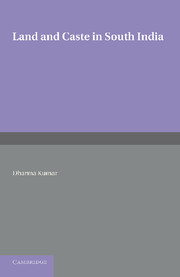 Land and Caste in South India
Land and Caste in South India Book contents
- Frontmatter
- Dedication
- CONTENTS
- List of Tables and Figures
- Acknowledgements and A Note on Certain Connventions
- Abbreviations
- Map of the Madras Presidency
- PART I
- I INTRODUCTION
- II THE AGRARIAN BACKGROUND
- III FORMS OF AGRESTIC SERVITUDE
- IV THE IMPORTANCE OF AGRICULTURAL LABOUR IN THE FIRST HALF OF THE NINETEENTH CENTURY
- V OFFICIAL POLICY AND THE EMANCIPATION OF THE AGRICULTURAL LABOURER
- VI OFFICIAL POLICY: LAND TENURES AND LAND REVENUE
- PART II
- Glossary
- Bibliography
- Index
I - INTRODUCTION
from PART I
Published online by Cambridge University Press: 05 June 2016
- Frontmatter
- Dedication
- CONTENTS
- List of Tables and Figures
- Acknowledgements and A Note on Certain Connventions
- Abbreviations
- Map of the Madras Presidency
- PART I
- I INTRODUCTION
- II THE AGRARIAN BACKGROUND
- III FORMS OF AGRESTIC SERVITUDE
- IV THE IMPORTANCE OF AGRICULTURAL LABOUR IN THE FIRST HALF OF THE NINETEENTH CENTURY
- V OFFICIAL POLICY AND THE EMANCIPATION OF THE AGRICULTURAL LABOURER
- VI OFFICIAL POLICY: LAND TENURES AND LAND REVENUE
- PART II
- Glossary
- Bibliography
- Index
Summary
In 1961 there were 31 million agricultural workers in India, that is to say, around one-fourth of the agricultural working force. Some of these labourers may own some land themselves, but these minute holdings cannot afford even bare subsistence for a family, and the major part of the labourer's income is derived from working on land owned by others. In this sense these labourers are ‘landless’. The exact definition of the term ‘agricultural labourer’ has been much debated in recent years, and what is more, has varied from one official enquiry to another, with the result that estimates of agricultural labourers in the same year, 1951, range from 18 per cent of the total agricultural population (the Census of 1951) to 38 per cent (the First Agricultural Labour Enquiry).But for our purpose these differences of definition are not important. It is clear enough that there has been a large group of landless labourers throughout the twentieth century, and that they are among the poorest and most depressed sections of Indian society; what is not clear is how long this group has existed and how it came into being. But these are problems of significance and not merely for Indian history.
The fortunes of this group are a good index of changes in the entire agrarian economy; movements in the numbers of agricultural labourers and in their wages reflect the growth of population, the extension of cultivation, the rate of industrialization, and the effects of integration in the world economy. And changes in the size and nature of the agricultural labour group may also throw light on the wider question of the effect of imperialist rule on subject societies. Did British rule shatter the structure of Indian society? Did it destroy the balance of the agrarian economy and create a new rural proletariat? Or did Indian social institutions possess enough resilience and vitality to absorb the changes brought about by foreign rule?
The study of agricultural labour attempted here covers a limited period and area. The period is the nineteenth century, during which British rule was consolidated, and one of the main tasks of the work is to estimate the size of the agricultural labour group at the beginning of the period.
- Type
- Chapter
- Information
- Land and Caste in South IndiaAgricultural Labour in the Madras Presidency during the Nineteenth Century, pp. 3 - 5Publisher: Cambridge University PressPrint publication year: 2013


